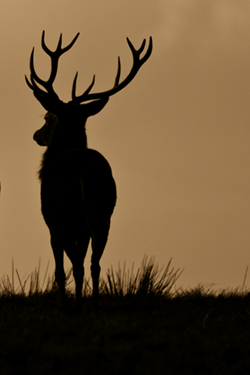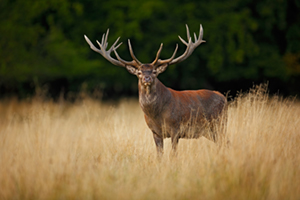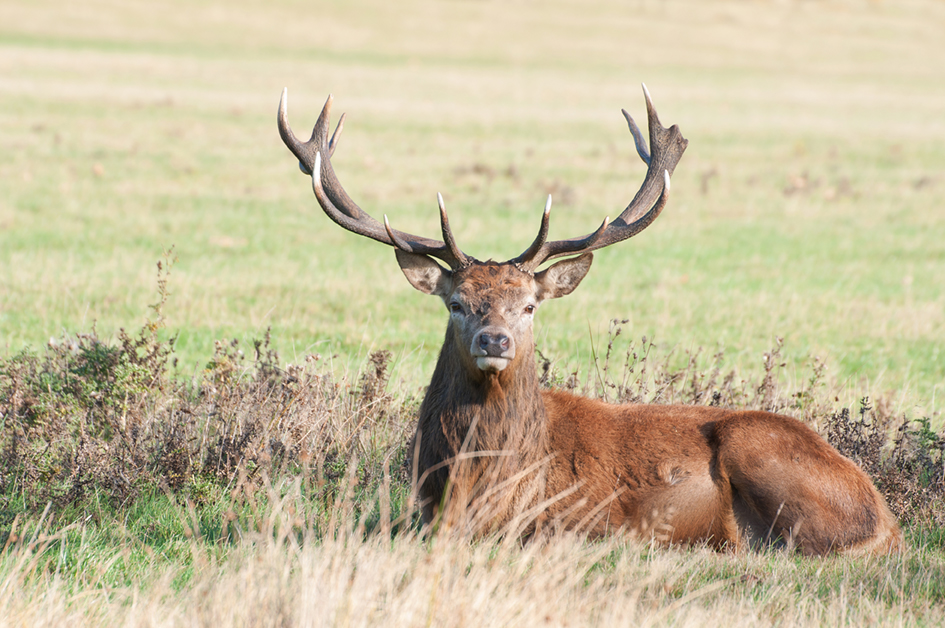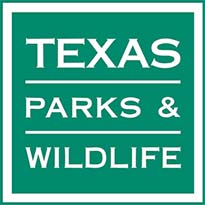Red Stag Hunting in Texas
Red Stag Hunts
The European red deer is one of the largest deer species
 The European red deer is one of the largest of the deer species, inhabits most of Europe, Asia Minor, Iran and central Asia and is the only deer species found in Africa. Red deer have also been introduced to Australia, New Zealand, the United States, Peru, Uruguay, Chile and Argentina. Large numbers of red deer are raised on deer farms throughout the world where they are valued for their meat, hides, horns and velvet.
The European red deer is one of the largest of the deer species, inhabits most of Europe, Asia Minor, Iran and central Asia and is the only deer species found in Africa. Red deer have also been introduced to Australia, New Zealand, the United States, Peru, Uruguay, Chile and Argentina. Large numbers of red deer are raised on deer farms throughout the world where they are valued for their meat, hides, horns and velvet.
Genetic evidence shows that red deer are not a single species but a species group, the exact number of which remains in dispute. The ancestor of all red deer probably originated in central Asia and resembled the Sika deer. American elk or wapiti were once thought to be part of the red deer species group but it has been recently determined that elk are a separate species of deer.
Contrary to popular belief and advertising, the red deer of New Zealand are not one of these separate subspecies of red deer but rather are direct descendants of European red deer introduced to the South Island of New Zealand in 1861 by Lord Petre from a herd he held in Thorndon Park near Essex, followed by a series of releases of red deer to the North Island from Windsor Great Park and elsewhere within the U.K. The huge antler sizes found today on Red Stags on the islands of New Zealand can be attributed more to available food supplies and possible interbreeding with released American elk than from some special or unique genetics.
Red deer first were first stocked on game ranches in the hill country of Texas in the 1930’s, and now number over 5,000, found in over 82 counties in Texas. Red deer were first stocked for hunting on the Farrell Ranch in the late 1970’s.
Both genders of red deer are reddish brown in summer with a yellowish rump patch and turn darker grey in the winter. The males grow a distinct neck mane.
Only the male red deer or Stag have antlers, which begin growing each year as soon as the previous years’ antlers are shed in February. Antler breakage, due to constant sparring and fighting during the rut or “roar”, diminishes the trophy quality of the antlers as the season continues. Red deer males develop “spike” antlers in their first year. As the Red Stag mature, the horns increase in number of points, length and mass with mature Red Stags sporting main beams from 24”-40” long that grow inwards at the top with typically 4- 5 points per side. Any tine, in excess of four on the main beam, often forms a cup or crown at the top, and those Red Stags are referred to as a Royal Stag- highly prized by hunters everywhere.
Red Stags attain sexual maturity at 24-30 months and their productivity begins to decline at about 8 years of age. One stag can breed about 30 – 40 hinds per season. The Stags reach 45-48 inches tall at the shoulder and weighs 350-550 pounds after reaching full adult size at 4-5 years. During the “roar”, a Red Stag will lose 20-35% of its body weight. The females or hinds reach maturity at about 24 months, are smaller than the males, standing 40-45 inches tall and weigh usually 165-220 pounds. Full adult size for a red deer hind is realized at 4 years of age. Calving is usually late May- June. Gestation is 7-1/2 months, with twins being rare.
 The red deer is both a grazer and a browser and is very adaptable with regards to diet. Increased competition for browse and forbs (preferred by whitetail deer and other species) push red deer to consume more grasses. Increased completion for grass (preferred by cattle) require red deer to consume more browse. Due to the large appetites of these big animals, red deer stocking levels must be closely monitored and managed so as to ensure the nutrition requirements are met for all animals on Farrell Ranch. Lifespan for Red Stag in Texas is generally 12-15 years. Mortality for the mature Red Stags is usually from fighting, with most red deer hind deaths occurring from simply old age. Predation is rare, as no predator on the Farrell Ranch, other than a mountain lion which may visit from time to time, has the ability to take down a red deer hind or Red Stag.
The red deer is both a grazer and a browser and is very adaptable with regards to diet. Increased competition for browse and forbs (preferred by whitetail deer and other species) push red deer to consume more grasses. Increased completion for grass (preferred by cattle) require red deer to consume more browse. Due to the large appetites of these big animals, red deer stocking levels must be closely monitored and managed so as to ensure the nutrition requirements are met for all animals on Farrell Ranch. Lifespan for Red Stag in Texas is generally 12-15 years. Mortality for the mature Red Stags is usually from fighting, with most red deer hind deaths occurring from simply old age. Predation is rare, as no predator on the Farrell Ranch, other than a mountain lion which may visit from time to time, has the ability to take down a red deer hind or Red Stag.
On the Farrell Ranch, Red Stags begin the rut or ‘roar” in early September and this period lasts until mid October. The Red Stags emit a distinctive “roar” or bellow during the rut instead of bugling like an American elk. This “roar” sounds very similar to a lions roar (hence the name) and is utilized to keep the Red Stag’s harem of hinds together. The hinds are attracted to the Red Stags whose roar deepest in tone and the most frequent. Additionally, it is used by the Red Stag to create dominance over other Red Stags. Fighting between Red Stags is brutal and constant during the roar with several Red Stags lost each year from wounds incurred while fighting.
After the roar, the Red Stags reform bachelor groups and attempt to recover from the roar by eating as much as possible before the onslaught of winter. The red deer hinds and the calves remain mostly in large groups and begin to separate from the Red Stags, until the following September when the cycle is repeated.
Chefs and hunters around the world prize red deer venison for its tender texture and great flavor. If you eat venison in any of the top restaurants anywhere in the world, it will most likely be red deer meat that you are enjoying. Being free-ranging, sustainable and all natural with no added hormones or antibiotics, the red deer venison you harvest on the Farrell Ranch is lower in cholesterol than chicken, 1/3 the calories of beef and has less than 5% fat.
Hunting Trophy Red Stag in Texas on the Farrell Ranch is not only fun but also very challenging. Red Stag, more than any other species on the Farrell Ranch, test every hunter’s ability to quickly and accurately place a good shot. Rifle accuracy, caliber and bullet selection are also incredibly important to ensure a successful hunt. These animals are very hard to secure and often a second shot is required-the hunter must be ready.
Red Stag hunts are typically conducted from vehicles, safari style (spot and stalk) or from fixed blinds near feeders and food plots as the Red Stags often concentrate in these areas after the roar.
To price your Trophy Red Stag Hunt simply add the Daily Fees of the type of hunt you want to the Red Stag Trophy Fee shown below. There are no extra fees, like you may see so often, for that Red Stag with “crowns” or that “Royal Red Stag”. These prices are for any mature Red Stag on the Ranch.
Texas Red Stag Hunts on Farrell Ranch are for 3 days and 2 nights beginning with hunter check-in at 1:30PM on the first day and check out by 11AM on the last day. Extra hunt days can be purchased with prior notice. Airport transportation and shipment of meat can be arranged.
Daily Fees
NOTE: If on mobile device, use your fingers to move the table to see all information. ← →
FULL SERVICE TEXAS RED STAG HUNTS: | ||
|---|---|---|
$450.00 per day per Hunter | Includes: Lodging, meals and daily guide fees, Ranch transportation, field dressing of game, temporary cold storage | Not included: Texas Red Stag Trophy/Management Fees, hunting licenses, tips, ammunition, alcohol, ice, transportation to and from Ranch, skinning, quartering, taxidermy, meat processing and or shipment |
$225.00 per day per Observer | Includes: Lodging, meals and Ranch transportation while accompanying Hunter | Not included: Transportation to and from Ranch, alcohol |
GUIDE SERVICE ONLY TEXAS RED STAG HUNTS: | ||
|---|---|---|
$300.00 per day per Hunter | Includes: Daily guide fees, Ranch transportation, field dressing of game, temporary cold storage | Not included: Texas Red Stag Trophy fees, lodging and meals, hunting licenses, tips, ammunition, alcohol, transportation to and from the Ranch, skinning, caping, quartering, taxidermy, or meat processing and shipment |
$150.00 per day per Observer | Includes: Ranch transportation while accompanying Hunter | Not included: Transportation to and from Ranch, lodging and meals, alcohol |
TEXAS RED STAG FEES
Texas Trophy Red Stag: $5,950.00
NO HARVEST NO PAY TROPHY FEE
Some outfitters keep all prepaid Trophy /Harvest Fees whether or not a Hunter is successful in taking their animal. On the Farrell Ranch, our policy is simple- if you don’t get your animal as specified in the Hunting Agreement, you are refunded the appropriate prepaid Trophy/Harvest Fees.
CASH OR CHECK
All prices show include cash or check discount from standard pricing.
CREDIT CARD or ELECTRONIC TRANSFERS
3% convenience fee will apply for all transactions made with credit cards or through electronic transfers.
TIPS & GRATUITY
A tip to the guide consisting of up to 10% of the Trophy or Harvest Fee (per animal/hunter) is customary in the Texas hunting industry. If you don’t receive the highest level of expected attention, feel free to reflect that discrepancy in your tip given.

Contact
Pat Farrell
11645 HWY. 6
Meridian, TX. 76665
Cell: 254.315.0303
Email Us
Click here for directions
Ranch Hunting Season
October through February

